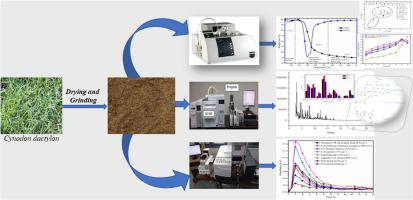当前位置:
X-MOL 学术
›
J. Anal. Appl. Pyrol.
›
论文详情
Our official English website, www.x-mol.net, welcomes your
feedback! (Note: you will need to create a separate account there.)
Thermal behaviour, Kinetics and Fast Pyrolysis Characteristics of Cynodon dactylon grass using Py-GC/MS and Py-FTIR analyser
Journal of Analytical and Applied Pyrolysis ( IF 5.8 ) Pub Date : 2020-09-01 , DOI: 10.1016/j.jaap.2020.104887 Ranjeet Kumar Mishra , Qiang Lu , Kaustubha Mohanty
Journal of Analytical and Applied Pyrolysis ( IF 5.8 ) Pub Date : 2020-09-01 , DOI: 10.1016/j.jaap.2020.104887 Ranjeet Kumar Mishra , Qiang Lu , Kaustubha Mohanty

|
Abstract Cynodon dactylon (DG) is a biological resource available in abundance across the world; and has the capability to yield sustainable renewable fuels and fine chemicals. The present study explored the bioenergy potential of DG biomass by evaluating its physicochemical properties, pyrolysis characteristics, and kinetic behaviouer with thermodynamic analysis (TD) for the first time. The physicochemical outcome established its bioenergy potential towards sustainable energy production. The thermal decomposition study of DG biomass was carried out in a thermogravimetric analyser (TGA) at dynamic heating rates (10, 30 and 50 °C min−1), under nitrogen atmosphere while Py-GC–MS was executed to understand the pyrolysis behaviour. The thermal decomposition profile of the DG biomass established multistage degradation, which is linked to the diverse components in its structure. The average apparent kinetic energy was found to be 208.89, 220.43, 211.90, 213.66, 214.28 and 192.30 kJ mol−1 for Kissinger-Akahira-Sunose (KAS), Ozawa-Flynn-Wall (OFW), Friedman (FM), Starink (ST), Distributed Activation Energy Model (DEAM), and Vyazovkin (VZ). Py-GC–MS results revealed that formation of phenolics, aromatic hydrocarbons and ketones in the temperature range 450–650 °C were increased while formation of cyclopentanones, acids, esters and other oxygenated compounds were reduced. Finally, Py-FTIR study confirmed that the majority of functional groups generated in the range of 4 −15 s.
中文翻译:

使用 Py-GC/MS 和 Py-FTIR 分析仪研究狗牙根草的热行为、动力学和快速热解特性
摘要 Cynodon dactylon (DG) 是一种生物资源,可在世界范围内大量使用。并有能力生产可持续的可再生燃料和精细化学品。本研究首次通过热力学分析 (TD) 评估其理化性质、热解特性和动力学行为,探索了 DG 生物质的生物能源潜力。物理化学结果确立了其实现可持续能源生产的生物能源潜力。DG 生物质的热分解研究在热重分析仪 (TGA) 中以动态加热速率 (10、30 和 50 °C min-1) 在氮气气氛下进行,同时执行 Py-GC-MS 以了解热解行为. DG 生物质的热分解曲线建立了多阶段降解,这与其结构中的不同组件有关。发现 Kissinger-Akahira-Sunose (KAS)、Ozawa-Flynn-Wall (OFW)、Star Friedman (OFW) 的平均表观动能分别为 208.89、220.43、211.90、213.66、214.28 和 192.30 kJ mol−1 ST)、分布式活化能模型 (DEAM) 和 Vyazovkin (VZ)。Py-GC-MS 结果表明,在 450-650 °C 的温度范围内,酚类、芳烃和酮的形成增加,而环戊酮、酸、酯和其他含氧化合物的形成减少。最后,Py-FTIR 研究证实,大多数官能团在 4 -15 s 范围内生成。Ozawa-Flynn-Wall (OFW)、Friedman (FM)、Starink (ST)、分布式活化能模型 (DEAM) 和 Vyazovkin (VZ)。Py-GC-MS 结果表明,在 450-650 °C 的温度范围内,酚类、芳烃和酮的形成增加,而环戊酮、酸、酯和其他含氧化合物的形成减少。最后,Py-FTIR 研究证实,大多数官能团在 4 -15 s 范围内生成。Ozawa-Flynn-Wall (OFW)、Friedman (FM)、Starink (ST)、分布式活化能模型 (DEAM) 和 Vyazovkin (VZ)。Py-GC-MS 结果表明,在 450-650 °C 的温度范围内,酚类、芳烃和酮的形成增加,而环戊酮、酸、酯和其他含氧化合物的形成减少。最后,Py-FTIR 研究证实,大多数官能团在 4 -15 s 范围内生成。
更新日期:2020-09-01
中文翻译:

使用 Py-GC/MS 和 Py-FTIR 分析仪研究狗牙根草的热行为、动力学和快速热解特性
摘要 Cynodon dactylon (DG) 是一种生物资源,可在世界范围内大量使用。并有能力生产可持续的可再生燃料和精细化学品。本研究首次通过热力学分析 (TD) 评估其理化性质、热解特性和动力学行为,探索了 DG 生物质的生物能源潜力。物理化学结果确立了其实现可持续能源生产的生物能源潜力。DG 生物质的热分解研究在热重分析仪 (TGA) 中以动态加热速率 (10、30 和 50 °C min-1) 在氮气气氛下进行,同时执行 Py-GC-MS 以了解热解行为. DG 生物质的热分解曲线建立了多阶段降解,这与其结构中的不同组件有关。发现 Kissinger-Akahira-Sunose (KAS)、Ozawa-Flynn-Wall (OFW)、Star Friedman (OFW) 的平均表观动能分别为 208.89、220.43、211.90、213.66、214.28 和 192.30 kJ mol−1 ST)、分布式活化能模型 (DEAM) 和 Vyazovkin (VZ)。Py-GC-MS 结果表明,在 450-650 °C 的温度范围内,酚类、芳烃和酮的形成增加,而环戊酮、酸、酯和其他含氧化合物的形成减少。最后,Py-FTIR 研究证实,大多数官能团在 4 -15 s 范围内生成。Ozawa-Flynn-Wall (OFW)、Friedman (FM)、Starink (ST)、分布式活化能模型 (DEAM) 和 Vyazovkin (VZ)。Py-GC-MS 结果表明,在 450-650 °C 的温度范围内,酚类、芳烃和酮的形成增加,而环戊酮、酸、酯和其他含氧化合物的形成减少。最后,Py-FTIR 研究证实,大多数官能团在 4 -15 s 范围内生成。Ozawa-Flynn-Wall (OFW)、Friedman (FM)、Starink (ST)、分布式活化能模型 (DEAM) 和 Vyazovkin (VZ)。Py-GC-MS 结果表明,在 450-650 °C 的温度范围内,酚类、芳烃和酮的形成增加,而环戊酮、酸、酯和其他含氧化合物的形成减少。最后,Py-FTIR 研究证实,大多数官能团在 4 -15 s 范围内生成。









































 京公网安备 11010802027423号
京公网安备 11010802027423号